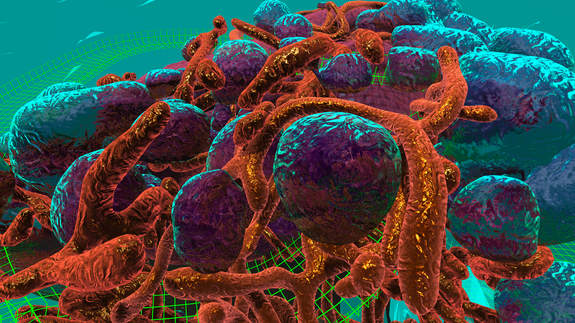Virtual reality allows scientists to walk into a cancer cell

After generations of peering into a microscope to examine cells, scientists could simply stroll straight through one.
Calling his project the "stuff of science fiction," director of the 3D Visualisation Aesthetics Lab at the University of New South Wales (UNSW) John McGhee is letting people come face-to-face with a breast cancer cell.
SEE ALSO: 'No Man's Sky' hack lets you travel the universe in VR
Using data pulled from a high-resolution electron-microscope at the University of Queensland, the expert in CGI has recreated the cancer cell in virtual reality.
McGhee told Mashable Australia his team uses Unity, the development platform for video games, to build a 3D mesh of the cell adding texture, colour, light and any effects.
Putting on a HTC Vive VR headset, scientists can essentially step into the petri dish and observe nanoparticle drugs being absorbed. They also use hand controllers to navigate the experience.

Image: unsw
For the moment, the experience is used primarily for educational purposes.
"Once you immerse in a headset, it's going to really help you to get your head around complicated processes versus if you just see something on a screen," he explained. "It's really allowing you to walk through data in a new way."
Using the Oculus Rift VR headset, another of McGhee's projects focuses on the potential use of virtual reality in the rehabilitation of stroke patients.
Steven Faux, director of rehabilitation at St Vincent's Hospital Sydney, has been working with McGhee for almost three years.
To create the experience, the medical team takes a patient's MRI or CT scan and determines the mechanism of the stroke they suffered, then a neuroradiologist removes any extraneous parts of the image. At that point, they give the data to McGhee, who turns it into a virtual tour of the patient's own blood vessels.
"We walk through the blood vessel with the patient and we recreate the stroke," Faux told Mashable Australia. "If it was a slow closing off the blood vessels, we show that ... if it was a clot that came from the heart and blocked a major blood vessel leading to the brain, we show that."
"It looks like something from the Raiders of the Lost Ark," he added.
For those who have suffered from a stroke, the incident can often leave them confused and cognitively impaired. Occasionally, they lose the ability to understand written or spoken language. Once they're on the path to recovery, the use of McGhee's experience can enhance their motivation to engage in rehabilitation.
Faux said the impact on patients is often remarkable. For many, it's the first time they've truly understood what happened to them.

Image: unsw
"We've shown it to about four or five [patients] and we've had dramatic responses with some of them," he said. "We showed an 18-year-old man who had suffered a brain haemorrhage while playing football. He was a bit shellshocked by it.
"He was shocked by how violent and damaging [the stroke] was."
Faux said the technology could have many applications, including for practitioner training and preventative health, but suggested it was difficult to obtain funding for such research.
In the years to come, McGhee also hopes to discover if 3D visualisations could have an impact on the discovery process by letting scientists see their data in an entirely new light.
He's also working on building the passing of time into the cell experience, as it's currently static. He hopes to create a virtual world where scientists can watch how cancer cells move through the body.
"Lots of data is collected on scanners, but it often doesn't see the light of day," McGhee said. "How do we get it out there and put it on engaging platforms?"
